
|
Note ye ed's email address: stevebryant99@gmail.com. |

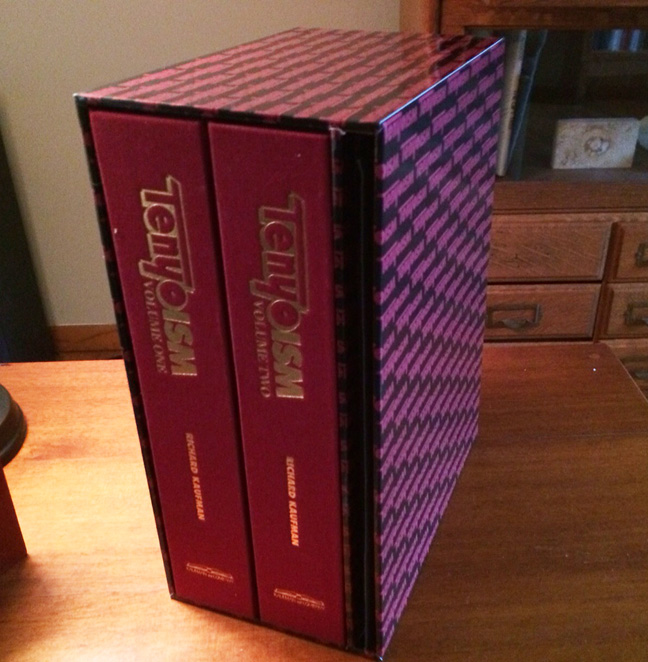
At last!
|
Last month's Christmas issue took a look at 20 years of Little Egypt Magic, at how to move Lucas Mackenzie and the London Midnight Ghost Show up the charts, and at Wladimir's Electric Deck Pro, Jim Steinmeyer's The Affirmative Code, and the Illusionists in London. |
January 2016 Christmas 2015 is in the books, and word is that Santa's in traction from delivering all those copies of Tenyo-ism. This month we start the year off with a look at the Tenyo books, at a two-DVD set from Bill Goodwin, at a Dai Vernon poster and deck of cards, at free stuff that came in some Christmas party crackers, at hopes for new publications in 2016, and at favorite gifts from Christmases past. Happy New Year to one and all, and I hope to see you at the conventions. Hey, Magi-fest is just around the corner. |
|
|
Santa was generous this year, dropping off a couple of New Yorker anthologies, Volumes 1 and 2 of the graphic novel of Neil Gaiman's The Graveyard Book, Jeff Daham's The Unauthorized Story of Walt Disney's Haunted Mansion, the two-volume Tenyo-ism, Bll Goodwin's Still Waters DVDs, and a Dai Vernon poster and deck of cards from Dan and Dave. As to those magic items ... JUST ONE WORD. ARE YOU LISTENING? PLASTICS. -- My first "real" (for adults) magic trick ws the Penetration Frame, from Martinelz Magic Mart in Florida, in 1958. I've no proof that it was a Tenyo trick, but it was certainly Tenyo quality (still works great 58 years later), and it established my fancy for ingenious magical apparatus made of plastic. 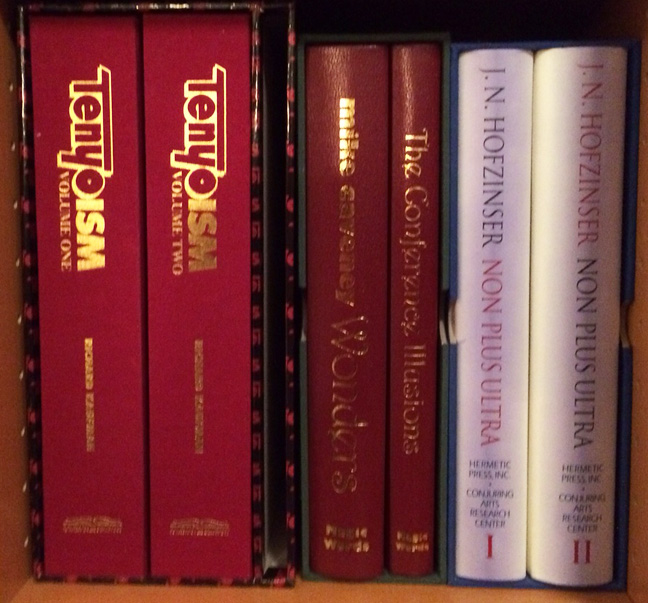 Boxed sets. Although the company dates back to the 1930s, the modern phase of Tenyo began under the hand of Akira Yamada, son of Tenyo Shokyokusai, himself a nephew of Tenichi. Yamada sought to open business in the west in the late 1960s via his own welcoming trip to the Magic Castle and via a visit to Japan from Dai Vernon and Larry Jennings. On a pivotal trip to England in 1972, a dealer refused to sell Yamada any magic because Japan had a reputation for ripping off material. Humiliated, Yamada returned home and vowed "no more copying," resolving to manufacture only original material. The first original line appeared in 1973, and Tenyo launched its Creative Division in 1976 featuring such creators as Hiroshi Kondo and Shigeru Sugawara. Yamada also negotiated rights to the Tarbell course and began a Japanese translation by Hideo Kato. One of the most honorable companies and an era of remarkable creativity were under way. By the 1990s, thanks to introductions by Mark Setteducati, genius creators such as Lubor Fiedler and Angelo Carbone began contributing to the line. With the weighty (over 20 pounds) arrival of Richard Kaufman's boxed set Tenyo-ism, I now appreciate this incredible company as never before. Tenyo-ism is a buffet of stellar magic, its two books (1263 pages) and bonus materials including the following: * History of Akira Yamada and his company. * Biographical profiles and paintings by Teruhide Sonoda of principal staff members, including Akira Yamada, Hiroshi Kondo (seminal creator and VP until 2014), Shigeru Sugawara (in 1977 and 1980 he created all four tricks in the Tenyo line), Kazumasa Shimizu (senior demonstrator; Tenyo Magic Corners in department stores have always been key to sales), Hideo Kato (Tarbell plus a book on Larry Jennings magic and edited Magic School, Tenyo's magazine), Gary Ouellet (wrote Tenyo instructions from 1978-1992), Tomoyuki Shimomura (Creative Division, wrote the Japanese instructions), Toro Suzuki (Creative Division), Steve Cohen (wrote instructions since 1997), and So Sato (Creative Division; So Sato stunned us at the Genii convention with his brilliant card magic), among others. * Catalogues of the standard public line of magic and the Magician's Selection line (sold to more serious amateurs and professionals). * Reprints of articles about Tenyo from Genii and Magic Manuscript. * New articles from Tenyo staff member. * Excerpts from Magic School (Tenyo's magazine, 77 booklets of over 1200 pages). * New handlings of tricks from the likes of Dan Harlan, Tomas Blomberg, Tom Stone, Michael Weber, Phil Goldstein, Richard Kaufman, and Mago Anton. * Descriptions, histories, and photos of the primary Tenyo line from item T-1 (1955) through T-263 (2014). This is the bulk of the book, all your favorite Tenyo tricks on display. * Descriptions, histories, and photos of standard magic apparatus sold to magicians only. These high key photos of classic apparatus (milk pitcher, zombie ball, etc.), over 66 pages, the most beautiful in the book, will make you feel like a kid again, dreaming of being a magician. * Descriptions, histories, and photos of Magician's Selection items. * Tricks by Creative Division staff, most published originally in Tenkai Prize books. Some 85 pages make this a book within a book. (If you "win" the Tenkai prize, you must publish a book of original material. Most have been in Japaneses only, but I happily possess one from 1988, by Phil Goldstein.) * Two DVDs of official demonstration videos. * One DVD titled Tenyo Scrapbook. 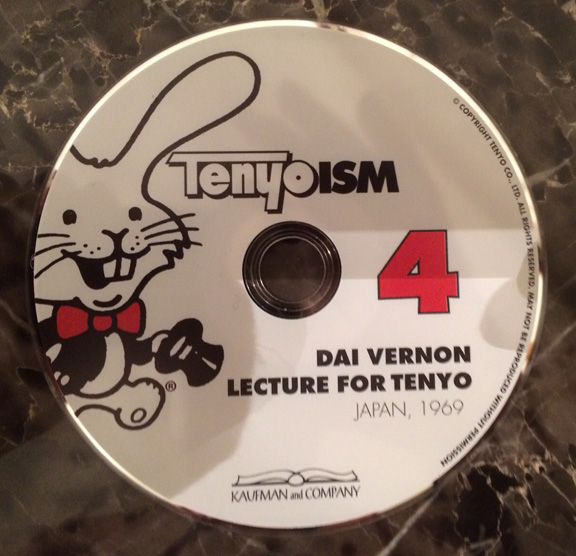 The extras are fun. * One DVD of the Dai Vernon and Larry Jennings lecture for Tenyo in 1969. * Three Plus One tricks. In Japan, purchasing a Tenyo item entitled you to a coupon, and three coupons entitled you to a Plus One trick, the only way to acquire a trick that packed flat for mailing. The three supplied with Tenyo-ism include Toro Suzuki's Illusion Scale, the trick I have previously purchased and hailed as Kitties. Both Andy Greget and Meir Yedid sell it and have their own routines. 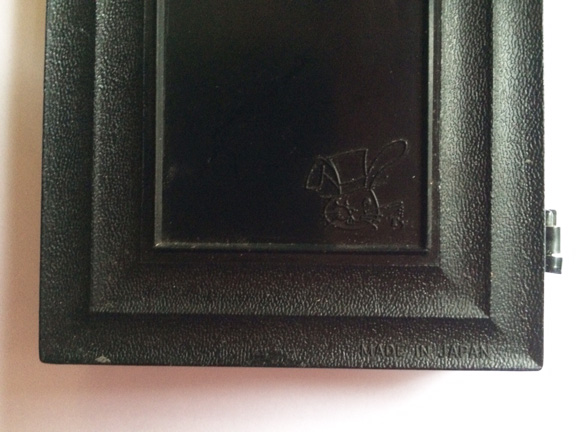 The bunny logo says Tenyo. Over the years, I have not been a Tenyo collector, but rather have simply purchased items that particularly appealed to me in given years. I confined my first serious skim of the books to items I owned (I was frequently distracted by others, nonetheless): Penetration Frame, Dental Dam, What's Next?, Card Case (I purchased two, for Arthur Monroe's Voodoo), See Thru Guillotine, Tunnel of Darkness, Crossroads, Midas Machine, Zig Zag Cig, Eclipse (a favorite, a mechanical version of Paul Harris's Twilight), Telesphere (another favorite, a mechanical Cups and Balls), Invisible Zone, Antigravity Rock, Blue Crystal, Illusion Scale, and Flying Carpet (my favorite from Lubor Fiedler, nothing else in magic like it; can you imagine the thrill of the staff when he first showed this to them?). 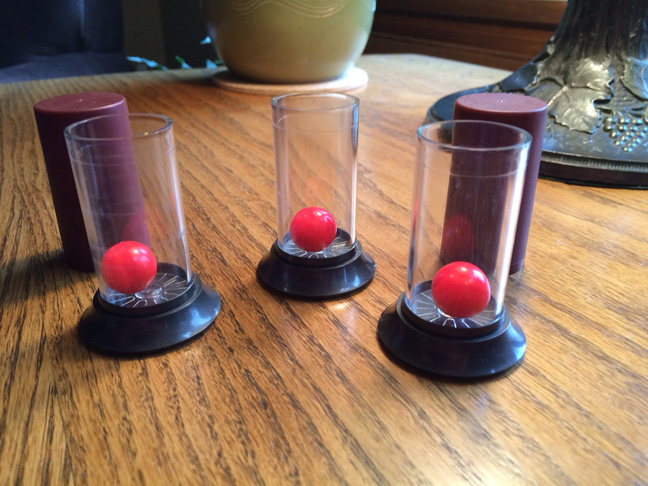 Telesphere -- world's easiest Cups and Balls. I regret missing a few in the process. I failed to acquire the Paddle Collection (couldn't afford it), Oh No (amazing severed finger), Clyde (rabbit puppet inspired by Stan Allen's bunny), Phantom Clock, Tiny Ring (baffling performance of this on the Scrapbook DVD), Magic Butterfly (love the handling with the jar), and The Haunting (skeleton visibly writes a message). And there were many Japan-only items I was unaware of. The classiest set of books I've seen in magic. Some 1300 pages on museum quality paper, slipcase, plus three tricks and four DVDs. $250 from Kaufman and Company, plus $50 shipping in the U.S. (And the packaging is going to impress you.) DEEP WATERS -- A lay friend and his party recently attended the Magic Castle as my guest, and the group encountered Bill Goodwin and Jamy Ian Swiss in the Peller Theatre. As my friend wrote later of the performances, "Their stage presence was first rate and their magic was off the charts." I would expect no less and must confess to some jealousy that my friends saw the show rather than I. My discomfort was lessened, fortunately, by the arrival of Still Waters, Bill Goodwin's two-DVD set of his original card magic. On the DVDs Bill performs and teaches ten tricks and moves, in exacting detail, but that is only part of their value. Mostly, these are valuable because they showcase an amazing sleight-of-hand artist performing beautiful magic of the style I first saw in a young Michael Skinner. Extras include three of the routines shot at the Magic Castle's Closeup Gallery on April Fool's Day, 2015. You witness first-hand how well they play. (The Extras also include an interview with Bill.)  Pure magic. The methods are as surprising and baffling as the execution. A Cannibal Cards routine fooled me badly because of some built-in audio chicanery. Audio also plays a deceptive role in Pocket Calculator. (I shouldn't have been fooled by that one as it is in Bill's mss Evolution. Alas, I fell in love with Duplex in that document and apparently stopped reading. The result is that I hadn't a clue.) I should warn that some of the requisite sleight of hand is a tier or more above mine (one routine requires a side jog faro, a top card cover pass, and a side steal), but some are in range and all are so well taught that you can get there if you put in the practice. The DVDs are accompanied by a 20-page document that lays out the credits, a most pleasing foray into the depths of modern card magic. It's the first time I recall anyone making use of Steranko's Shadow Steal. It should surprise no one that Bill Goodwin has the background of, say, a librarian. (The mss also includes a bonus four ace trick.) Two DVDs shot in high definition with multiple camera angles, handsomely produced, plus color manuscript. $49.95 from billgoodwinmagic.com. Recommended as a teaching resource but also highly recommended for entertainment value. I've been watching mine over and over. MALEFICENT AND THE PROFESSOR -- Jon Racherbeumer's audio column in the January Genii surprised me with a quote from Lin Searles in Ibidem in 1960: "what do you say when some jackass louses up a legend?" Lin was referring to the first volume of the Vernon Inner Secrets trilogy, and the jackass was Lewis Ganson. This surprised me because early in my marriage, nine years later, my wife approached Lin Searles for a Christmas gift recommendation, and he recommended the trilogy. It was, until this Christmas, the only time my wife had surprised (and delighted) me with a magic item. (In fairness, P. Howard Lyons added back in 1960 that the second Vernon book was out and "was as good as the first was disappointing." Perhaps Lin's estimation also rose over the evolution of the series.) 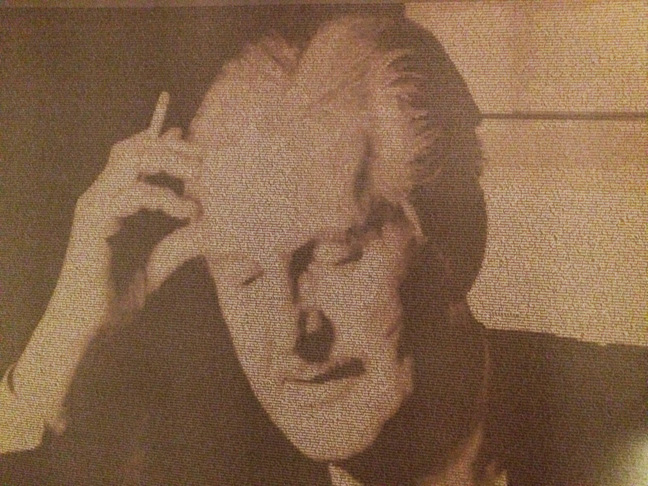 The Professor in study (partial image). Fast forward 46 years to a second magic-related Christmas gift, a Dai Vernon poster and deck of cards. This "A Tribute to Vernon" by Dan Frederickson from Dan and Dave includes an uncut sheet of cards 22 by 26.5 inches featuring the Ross Bertram photo of Vernon but composed of tiny text from Erdnase, a matching deck of cards, a museum-grade placard describing the uncut sheet, and a playing card with Vernon's signature on one side and "Be natural" on the other. Each item from a signed and numbered edition of 500 is lovely, from the Bucks, $52. I can't wait to see what she buys me in 2061! |
|
|
THE GRANDDAUGHTER VARIATION -- My granddaughter, Audrey, is half-British, and part of her heritage for celebrating Christmas is party crackers, decorated cardboard tubes that you pull on to yield a loud bang and various treasures within. The typical contents include a printed joke or riddle, a tissue paper crown, and a small toy or trinket. This Christmas, with some crackers purchased from Pier 1, the small toys were magic tricks, some in plastic like mini-Tenyo tricks. 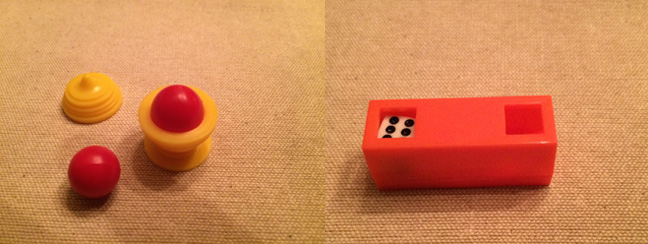 Ball and Vase/Dice Tunnel. Given their miniature size and throw away value, all the items were very well made. The specific range included a Mystery Calculator (we've seen this one in previous Christmases), a Dice Tunnel (value changes as a die travels from one end of a tube to the other; she fooled me with this one), a Ball and Vase, a Sword Through Finger, a Two-Card Monte (with three cards), a Zig Zag Lady, and a Grandmother's Necklace with a wooden bead and two lengths of cord. 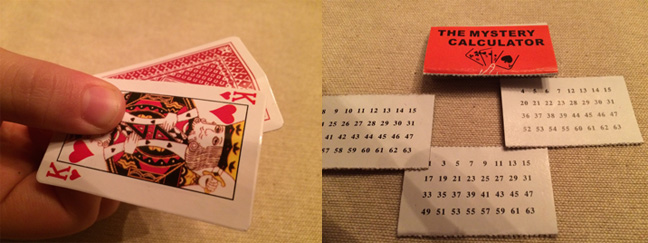 Two Card Monte/The Mystery Calculator. 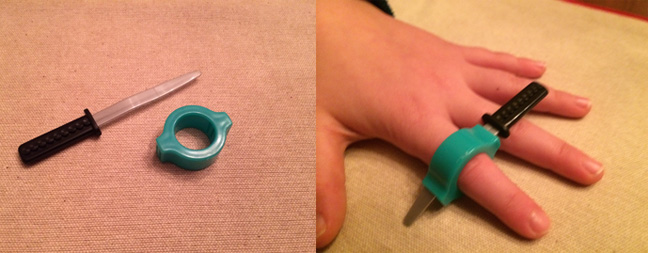 Finger Sword. I call your attention to that last item. Because Audrey had never seen these tricks before and was learning them through minimal tiny instructions, she wasn't bound by traditional handlings. As a result, she came up with a significant new handling for the Grandmother's Necklace that initially baffled me. As most of you know, the trick is accomplished thanks to two U-shaped lengths of string (bights), one being folded into the other, and then the bead slipped over this rigged section. It now appears that two lengths of string are fairly threaded through the bead and that it would be impossible to remove the bead without letting go of the ends. The photo of Audrey below illustrates the situation. So here's the part that fooled me. By first raising one hand and then the other, she caused the bead to slide freely back and forth from one hand to the other. I had never seen this done before and was convinced the trick was going to fail. Clearly, she hadn't gaffed the situation. But she proceded directly, and the bead escaped as usual.  Grandmother's Necklace. "What the heck? How did you do that?" Ah, I'm going to tell you, but take a blood oath first! What she did was pinch the looped bights between her fingers. The bead isn't over this pinched section and can therefore slide back and forth on only one (bent) piece of string. When it is time to continue the trick, she let the bead slide down to where her fingers pinched the bights and used her thumb to pull the bead the rest of the way, over the joined bights. This concealed situation was (for me at least) always the starting point of the routine, but Audrey got there more in the middle of her routine, and that made all the difference. It looked like magic. BTW, bonus points if you recognized the title. It's dated British slang that appeared in Mad magazine in the 1950s and always struck me as both comical and deep. |
|
|
WISHES FOR 2016 -- I begin each year with hopes for amazing new publications. Some of these follow, some realistic, some not, but just as heartfelt. Nick Trost's Subtle Card Creations Volume 6 from H&R. Jamy Ian Swiss's book on Johnny Thompson. The Jerx Volume 1 from the mysterious Andy. Is it really $260? Richard Kaufman's books on Deland and Larry Jennings (Mr. Jennings Takes It Easy). So Sato's book from Richard Kaufman. I really want to know how So Sato did his Follow the Leader trick. 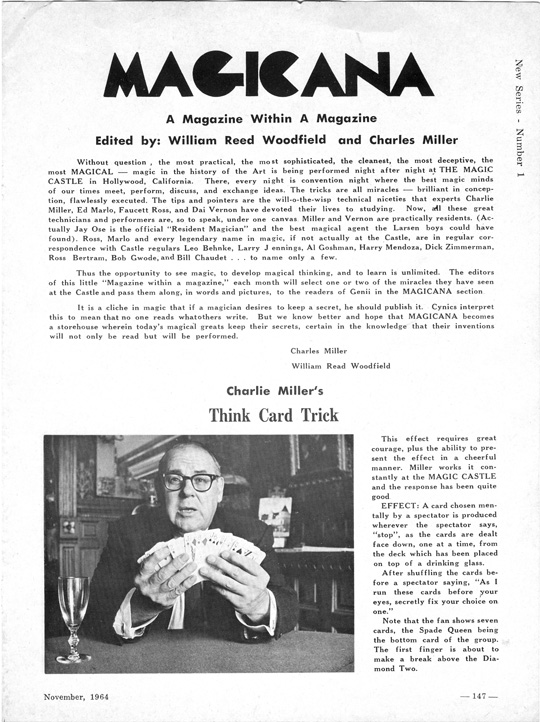 Issue 1 of Magicana. Magicana -- the Charlie Miller Years from Richard Kaufman. I wish for this every year. Richard is sitting on one of the best books in magic, similar to Jim Steinmeyer's The Conjuring Anthology. (Subscribers of course can access this one issue at a time.) A book on The Trick That Cannot Be Explained by Eugene Burger. Or any book by Eugene. A new Impuzzibilities book from Jim Steinmeyer. A book on 60 years of It's Magic from Milt Larsen and others. That anniversary looms. Any new magic trick from Gordon Bean. A new periodical from Karl Fulves. A book on Simon and Ginny Aronson's mind reading code. My next novel from Month9Books. The title is still a secret. Meanwhile, enjoy reading Lucas Mackenzie and the London Midnight Ghost Show. That's enough for a start. What are you wishing for? WISHES FROM LONG, LONG AGO -- Having recently purchased gifts for grandchildren, I note that most of the financial outlay goes to Lego sets and video games. Although the Lego sets are vastly improved over those bought for my own children (never had any Legos of my own) and the video games are high res and fantastic, I must ask: do my grandchildren's Christmases outshine those of my own childhood? I think not. In my small hometown (no Toys R Us, no Amazon), toys were available in only two ways. A hardware store and a paint store each stocked its shelves with toys two weeks before Christmas, and there was the Sears Christmas catalogue. These sources yielded such wonders from the 40s and 50s as: A.C. Gilbert Mysto Magic Set. The granddaddy of all Christmas presents, early magic heroin. I've run this photo before but am happy to run it again.  My first magic set. Ouija board. William Feld's famous talking board for communicating with the dead. We were at an age to believe it. View-Master. The ultimate 3D viewing device, from Sawyer, with reels I don't think they make anymore, breathtaking scenes shot of physical sets, not merely cartoon drawings. I loved the three-reel sagas such as Peter Pan. The 2016 View-Master is a virtual reality device that uses your iPhone, but I'll take the original, thank you. Lionel electric trains. I understand that some now cost as much as $1000, but I still prefer mine, the one that put out little blasts of smoke. BB gun. My pump action Daisy was my favorite and the scourge of neighborhood critters. I've outgrown my homicidal ways but still find occasions that make me wish I owned one. Perhaps I can concoct a magic trick. Chemistry set. I had several, and while they were instrumental in getting me interested in science, they mostly got me and my friends interested in mischief. And there were Chemical Magic manuals that proved science could be entertaining. Foto-Electric Football. This was a light board that pitted a scrambling offensive run against an array of defenders, each pattern illuminated, not one of those vibrating fields that had little players shimmying about randomly. A Jon Gnagy art set. This was based on a Saturday morning television show ("Learn to Draw with Jon Gnagy") out of St. Louis, a step by step set of instructions on how to draw beautiful images with carbon pencils and black chalk. It made us feel talented. Hardy Boys mysteries. These were the only retail books available in my hometown, and they fostered a love of reading. |
 Bill Goodwin's credits send me back to original sources.
And there's a hand, my trusty fiere!
And gie's a hand o' thine! And we'll tak' a right gud-wellie waught, For auld lang syne.
Start off the year with a frighteningly good read. Order Lucas Mackenzie and The London Midnight Ghost Show today.

Follow us on Twitter. Little Egypt Magic is the erratically updated web site of Steve Bryant, spawned (the site, not Steve) by a former internet magazine known as The Little Egypt Gazette/for magicians only. Steve Bryant is an obscure magician and writer who generates this site from an iMac in Bloomington, Indiana. He used to frequently journey to and perform magic in Little Egypt, the local name for extreme southern Illinois, where the towns bear such names as Cairo, Thebes, and Karnak. Past issues of this web site: Index to Past Issues Notice: Any limited use of copyrighted images or quoted text is considered fair use, usually to review whatever product or event that is under discussion. If you object to use of any material, please get in touch and it will be cheerfully removed. |
A JSB Creations product
Copyright© 2016 by Steve Bryant